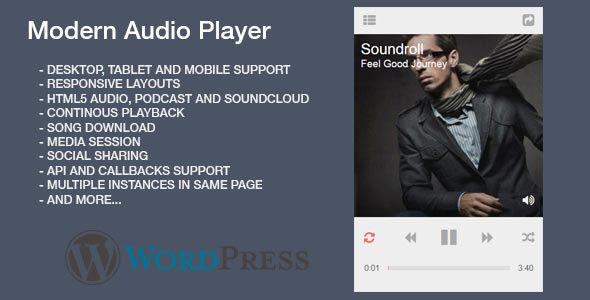

- Html5 audio autoplay loop install#
- Html5 audio autoplay loop android#
- Html5 audio autoplay loop download#
preload=”metadata” tells the browser to download information like tracks and duration, but to wait to buffer the audio until the user selects play. preload=”auto” (same as the Boolean preload in the example) leaves it up to the browser to decide whether to begin downloading. The preload attribute suggests how the browser should buffer the audio, according to the specified value: The user can then override this if volume controls are provided. The Boolean attribute muted does just what it says: mutes the audio file upon initial play. This attribute is valid for all media elements, so it is possible to link audio to audio, as well as audio to video and video to video. Each media element with the same keyword value for mediagroup is, essentially, linked and can be manipulated for playback via the DOM. Mediagroup is another relatively new attribute that is used to tie together multiple media files for synchronized playback. But if you must use it, I recommend including the controls attribute alongside loop. Like autoplay, I’m not a particular fan of this attribute because it takes control away from the user. This is a very new attribute introduced for all media elements ( and too) to address playback issues with Cross-Origin Resource Sharing (CORS).ĭepending on the scenario, crossorigin can be declared with an empty string or with CORS settings attribute keywords: user-credentials or anonymous.Īnother Boolean attribute, loop, tells the browser to loop the audio when playing. If you do decide to utilize autoplay, please be sure to include the controls attribute (or roll your own custom controls) so that your users can stop the audio or reduce volume.Ĭrossorigin is used to indicate if an audio file is being served from a different domain. This is a usability no-no for most scenarios, so exercise restraint in using this attribute. The Boolean autoplay attribute is one that I don’t recommend using because it specifies that the audio begin playing as soon as the page loads. It also includes the controls attribute, which tells the browser to use its default control interface for audio.Īs you can see in Figure 2, each browser has a different default for player controls but all include the basics: play/pause toggle, timeline progress bar and volume control.īeyond src and controls, has several other attributes you can utilize to further modify how your audio file will load and play. This includes the src attribute I already discussed, which embeds the specified audio file into the page. To add a simple audio player to your web page, all you need is a single line of markup: Sound good? Then let’s get started adding embedded audio in our web pages! Html5 audio autoplay loop android#
It also means more front-end control for responsive, dynamic designs and potentially better accessibility.Īs far as browser support goes, enjoys support by all of today’s latest browsers, including mobile browsers for iOS 4+, Android 2.3+ and Opera Mobile 11+. This means that creating a custom player is simply a matter of writing HTML, CSS and JS. Not only does native audio deliver independence from plug-ins, it can be targeted with CSS and JavaScript. It works much like the tried-and-true element, embedding the audio file into a web page via the src attribute: This new element allows you to deliver audio files directly through the browser, without the need for any plug-ins. And let’s not forget that to build a custom player with these plug-ins requires knowledge and expertise in that SDK. Then there are the front-end design hassles like trying to get a dropdown menu to display on top of a plug-in-based player. Also, many players built with these plug-ins are inaccessible, making it difficult for folks who use assistive technologies to access the audio or alternative content.
Html5 audio autoplay loop install#
This was not a bad world, but it had its issues.įor one, most plug-ins require the user to install them, but not all users are willing (or able) to install them. Once upon a time, audio on the web lived primarily in the world of third-party browser plug-ins like Flash, QuickTime and Silverlight.





 0 kommentar(er)
0 kommentar(er)
